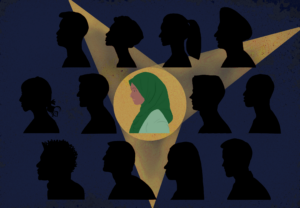For you, a thousand times over.
This iconic sentence from Khaled Hosseini’s The Kite Runner is well known by readers of contemporary fiction. The novel, a New York Times bestseller, has become a modern classic, garnering enough traction to secure a Broadway debut of its stage adaptation this past July. Though deserving of its fame, the novel’s content and popularity fit into a complex trope regarding narratives about Black, Indigenous, and people of color (BIPOC).
Throughout literature, film, and television, it seems that the majority of popular stories centering characters of color in the U.S. primarily focus on sadness. Oftentimes, these stories focus on some combination of generational trauma, war, poverty, abuse, or an identity struggle that leaves the story with a dark cloud hanging over it. Think Min Jin Lee’s Pachinko, Mohsin Hamid’s Exit West, or Chimamanda Ngozi Adichie’s Purple Hibiscus—all novels where suffering is central to the plot.
Of course, these authors and their works are critically acclaimed for a reason: Their writing prowess has enabled them to touch hearts and minds of millions of readers around the globe. They have also contributed to the diversification of media—we are experiencing a period of unprecedented representation. Additionally, there is no denying that the inclusion of hardships completes stories: It adds depth and richness to any plot, and character development often runs parallel to experiencing friction. Sharing stories that discuss the difficulties unique to communities of color also raises awareness about the realities of BIPOC experiences in a media space that is still incredibly white. Thus, these stories should and must be told, but an issue arises when they are the only ones given attention.
The reality is, publishers and film companies generally won’t give a project the green flag unless they believe the proposed story is profitable. But what is considered “profitable” is based on the tried and true: What kinds of products have achieved critical success in the past? When it comes to stories centering BIPOC, this tried and true is a trauma narrative. Celebrated authors of color—your Toni Morrisons, Amy Tans, and Jhumpa Lahiris—wrote extraordinary books that oftentimes focused on trauma and are now modern classics. Their success, while merited, has established a legacy of trauma narratives that publishing and production companies are perpetuating for the sake of profitability. Now, when audiences try to even think of a story about people of color that is simultaneously about joy, many find themselves at a deadend.
For stories about people of color, trauma has become entwined with profitability. The continued dominance of trauma as the prevailing narrative has set a dangerous precedent for what sells and what doesn’t. For example, Lee’s Pachinko follows a Korean family from their roots in Korea to their new home in Japan. Documenting experiences of different descendants of the same family, the novel examines generational trauma, as the parents, children, and grandchildren grapple with immigration, discrimination, and poverty. While this novel does not specifically focus on an American experience, its popularity among American audiences is a testament to the notion that sadness is required to become a bestseller for a story centering BIPOC. Strife, pain, and misfortune guide the most popular kind of storytelling, squeezing more lighthearted works out of the spotlight, while white-centric media still sees a plethora of sunny rom-coms, sci-fi adventures, and fantasy wonderlands. This further begs the question: Why is this formula successful in the first place? In an increasingly diverse nation, why are so many of the stories about people of color still so deeply sad?
Dominant representation of trauma-centered narratives paints a misguided image that happiness is rare—or even unattainable—for people of color. The result is a one-dimensional representation of life experiences, suggesting that BIPOC can only be characterized by trauma or negative experiences. While reading stories about racialized harm can be healing, doing so should be an active choice. It should be avoidable.
But with the prominence of trauma narratives, it is difficult for people of color to access media that is both representative and joyful. Fiction and story-telling can often be used as a means for escape, a break from the unpleasant aspects of life, but the ubiquity of trauma narratives makes this difficult for people of color, who find their few choices of representative media center around the harsh realities they already know so well.
But stories need not conform to the trauma narrative mold to gain popularity, as already proven by multiple other narratives centering BIPOC. Kevin Kwan’s Crazy Rich Asians is one example of a feel-good story that saw both literary and box-office success. ABC’s Abbott Elementary, Hulu’s Ramy, and Netflix’s Never Have I Ever are a few recent examples of more light-hearted BIPOC stories that still achieved critical success and popularity. Although these stories incorporate the harsh realities that come with racial marginalization, they are not solely grounded in trauma, but maintain a comedic and fun tone, allowing BIPOC to see themselves represented while still having a laugh. These works, however, remain outliers among stories surrounding people of color. BIPOC stories with lighter tones are still emerging in the literary and film worlds and frequently find themselves overshadowed by their heavier counterparts.
While breakthrough BIPOC narratives may have involved the main characters living through catastrophe and coping with historical abuses, the foundation for increased representation in media has already been established. Now there is an opportunity to diversify the types of stories used to achieve this representation. Communities of color deserve to see themselves represented in stories of success, love, and happiness.
While it remains important to bring attention to real injustices these communities face, people of color are entitled to representation in the fullest measure. They deserve to be imagined thriving and to have media industries value their happy selves just as much as their sad halves. Better representation means new opportunities for dreaming, for imagining a happier world where their existences are not boiled down to the negatives. It is essential to move beyond the profitable mold of trauma narratives and create enough stories for people of color to see themselves love, laugh, and smile—a thousand times over.





